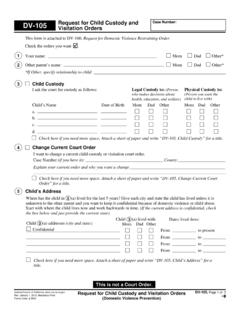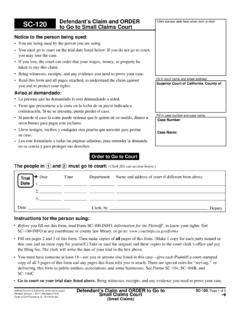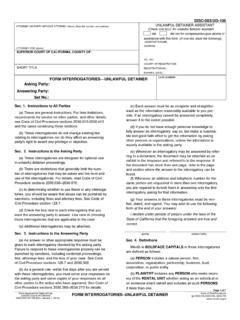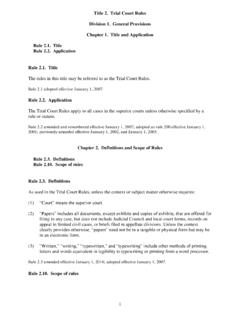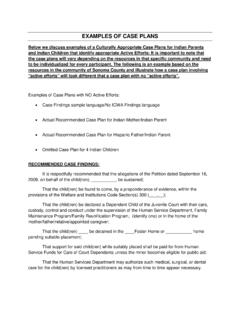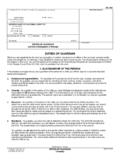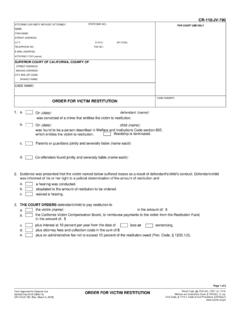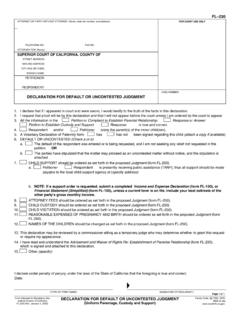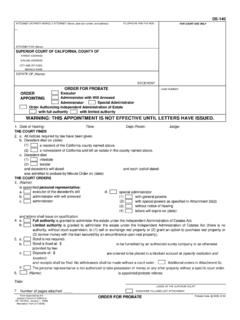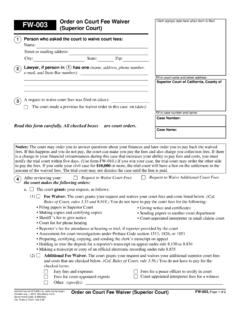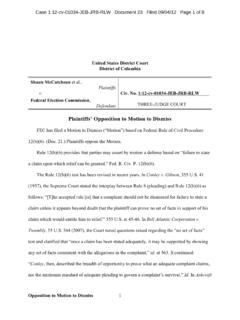Transcription of SUMMARY JUDGMENT AND DEMURRER - California
1 Appendix 5 SUMMARY JUDGMENT AND DEMURRER Demurrers and SUMMARY judgments represent special circumstances that necessitate slightly different procedural requirements throughout the appellate process. The three most important differences occur in determining the appealability of your appeal, identifying the order or JUDGMENT from which you can appeal, and in identifying the facts in the process of writing the brief. Those differences are discussed below. APPEALABILITY DEMURRER Sustained Without leave to Amend If a plaintiff files a case in superior court and the facts in the complaint do not state a cause of action (that is, they give no legal basis for the defendant to be held responsible for any damages claimed by the plaintiff), the defendant may bring a DEMURRER as king that the case be dismissed.
2 If a cause of action has been stated, the superior court overrules the DEMURRER and the case continues on. If no cause of action has been stated but the court believes there may be more facts that will enable the plaintiff to state a cause of action, the court sustains the DEMURRER "with leave to amend," in which case the plaintiff can restate his or her case in an amended complaint. If the court believes the complaint does not state a cause of action and cannot be amended to state a cause of action, the court will sustain the DEMURRER without leave to amend and the case is dismissed. The DEMURRER ruling is an order which, by statute, may not be appealed. (Code of Civil Procedure, section 581d.) In order to appeal this decision, the order sustaining the DEMURRER without leave to amend must say the case is dismissed or a separate JUDGMENT of dismissal must be entered by the trial court (for more information, refer back to Chapter 1.)
3 SUMMARY JUDGMENT In a SUMMARY JUDGMENT , one party may contend there are no facts that need to be decided, or the parties may agree on what the facts are. Either side (and sometimes both sides) may bring a motion for SUMMARY JUDGMENT arguing that they are entitled to a JUDGMENT in their favor without a trial. Unless the parties agree that there is no genuine dispute about material facts in the case, the court must determine whether there are any such disputed facts. Unlike a DEMURRER , the court is not limited to the allegations of the complaint, and it will review sworn statements or other evidence submitted by the parties in writing. The court will then decide if there is conflicting evidence in the record as to the material facts. Where the court finds that there is a genuine dispute as to material facts, the SUMMARY JUDGMENT motion will be denied because the evidentiary conflict must be resolved in a trial.
4 Where there is n genuine issue of material fact, the court will Appendix 5 grant SUMMARY JUDGMENT in favor of one of the parties. For example, if all the evidence shows that the light was green, the court does not need to hold a trial to determine whether the light was red or green. A trial court's order granting a motion for SUMMARY JUDGMENT is not appealable. A party seeking to appeal the ruling must first get a final JUDGMENT based on that ruling (again, for more information, refer back to Chapter 1.) Once a final JUDGMENT is entered, an appeal may be taken to review both the JUDGMENT and the SUMMARY JUDGMENT order. STATEMENT OF THE FACTS IN THE BRIEF Your statement of facts will be different if the case was dismissed or JUDGMENT was entered without a trial. In such a case, the facts have not yet been established by the trial court.
5 Demurrers and SUMMARY judgments are two types of pretrial motions that may cause a case to be decided without a full trial. Because cases are commonly decided by sustaining a DEMURRER or granting a motion for SUMMARY JUDGMENT , we shall explain a little about how to write the statement of facts when appealing from such a dismissal. DEMURRER Sustained Without leave to Amend The only issue in an appeal after dismissal from a DEMURRER sustained without leave to amend is whether the trial court erroneously found that the complaint failed to state a cause of action for which relief could be granted. On appeal, the Court of Appeal looks only at the complaint and assumes all of the factual allegations are true in order to rule on whether the complaint states a cause of action. Thus, the Statement of Facts in the opening brief should be based on and should emphasize the facts as alleged in the complaint and why they are a sufficient basis on which to seek relief in the court.
6 SUMMARY JUDGMENT In looking at the facts on appeal after a SUMMARY JUDGMENT , the question is exactly the same as the issue before the trial court: Is there a genuine dispute as to material facts that must be resolved at a trial? If there is such a factual dispute, SUMMARY JUDGMENT should not have been granted, the JUDGMENT should be reversed, and the case should go back to the trial court for a trial. Thus, if you are the appealing party, your Statement of Facts should emphasize the evidence in the record that you believe conflicts with the trial court's ruling. You should point out the evidence which demonstrates there is a factual conflict that must be resolved in a trial. Your arguments should be supported by appropriate page number citations to the record.
